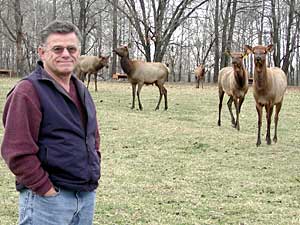|
Audio
Photos
Resources
Your Voice
|
Chronic wasting disease dangers still unclear
November 7, 2003
 |
| Elk farmer Larry Winter has had his herd tested for CWD for almost 5 years. The 2 cases of the wasting disease in Minnesota have been on elk farms. (MPR Photo/Annie Baxter) |
St. Cloud, Minn. — On a crisp, fall day, elk farmer Larry Winter gives a tour of his grounds. Off in the distance, about 70 honey-colored elk are grazing in a field. But you have to penetrate a series of 10 foot fences to get to them.
For Larry Winter, the fences offer an important barrier. They keep the elk from mingling with wild animals that might carry disease.
Winter has been testing his animals for CWD for almost five years. But in some ways, the recent CWD scare was bigger than any precautions he could take. He lost markets and money.
"We're not up to where we were before, because we were shipping all over the United States, now we're shipping to a couple of states," Winter says. "We are moving a lot of animals. But our market would be twice what it is if CWD were over, and they were to start opening the other borders in the country."
 | |||
As worries over CWD die down, things have been improving slowly for Winter. But the wasting disease still seems to produce a low-grade anxiety, especially among researchers.
Wayne Edgerton is an agricultural policy director with the DNR. He's frustrated by all we don't know about the disease.
"The whole issue of how this is transferred from animal to animal is still a little fuzzy," Edgerton notes. "The scientists haven't been able to figure out for sure how it happens and when it happens."
Edgerton says CWD might be transmitted through nose to nose contact between animals. And it probably proliferates in areas with dense animal populations. That seems to be the case in Wisconsin, where more than 200 animals have been infected.
Testing for the disease is cumbersome because brain and nervous system tissue can be tested only after an animal is killed. For now, the Minnesota DNR won't deliberately kill animals to gather CWD information. It will just collect more samples from deer taken this fall, and from farmed elk that are slaughtered or die naturally.
But Edgerton says the DNR's methods will change if there's an outbreak in Minnesota's wild deer populations.
"The key there is, if it is found, to take very precise, focused efforts in those areas to deal with that population, to get the population level down low enough so it won't spread," Edgerton says.
So far nothing indicates the disease can spread to humans. So the fear about its repercussions is somewhat abstract.
 | |||
"I don't think the worry is about the disease in some literal sense," says Suzanne Ross, Saint Cloud State University English Professor.
Ross researches the language of ecology. She says there's an important relationship between CWD anxiety and the terms we use to talk about the disease.
Words like "surveillance," "border patrol," and "rogue agents" evoke the war against terrorism. And that language might lend CWD discussions an extra, albeit false, urgency.
"These are the kinds of issues that are so in the public mind right now that they are shaping discourses in other arenas, and this is just one," Ross says.
But those abstract fears about CWD don't seem to concern hunters. And they're the people who are most likely to come into contact with diseased animals.
 | |||
In the past month, hunters have been pouring into Scheels Sporting Goods in St. Cloud. Cashier Craig Meier says hunting license sales have been steady.
"As soon as it opened up, people were really buying 'em up," Meier says. "And it seems to see more and more as it gets closer to season."
Customers like Dale Dingman say CWD won't thwart his hunting plans.
"I'm not going to worry about it," Dingman says glibly. "I think you should be careful and take precautions, and wear gloves and not touch the brain matter or spinal cord."
And David Lincoln says he's not worried, so long as he hunts in Minnesota.
"I have no concerns about shooting a deer with chronic wasting in Minnesota at all," says Lincoln.
But Lincoln says he and his friends won't hunt in Wisconsin.
 | |||
"We thought about it when we heard about it from Wisconsin," Lincoln says. "We thought 'Geez!' They hunted there before but now they won't hunt there anymore either. They figure it's safer here in Minnesota."
In a lot of ways, the dangers of chronic wasting disease are as big as people say they are. But without hard evidence of CWD's danger to humans, the threat remains hypothetical.
Is it all paranoia? Elk farmer Larry Winter thinks so.
"You take something like CWD, it comes up, and somebody grabs a hold of it and makes it more than it is, and blows it out of proportion," Winter says.
But as Winter decries other people's paranoia, he has his own worries.
He's actually a little nervous about the fences that he's built to keep wild animals from his elk. Some new cases of CWD in Wyoming make him think his fences might be more penetrable than he previously thought.
"There's no elk farms in Wyoming at all, none, and three new areas in Wyoming have come down with CWD," Winter says. "So that's a really good question of where is it. Because maybe our animals will get it through the fence from the wild animals."
But so far, the only CWD cases in Minnesota have been in farmed elk. Until there's a case in the wild deer population, it will be hard for anyone to tell where the dangers are: inside or outside the fence.
|
News Headlines
|
Related Subjects
|
